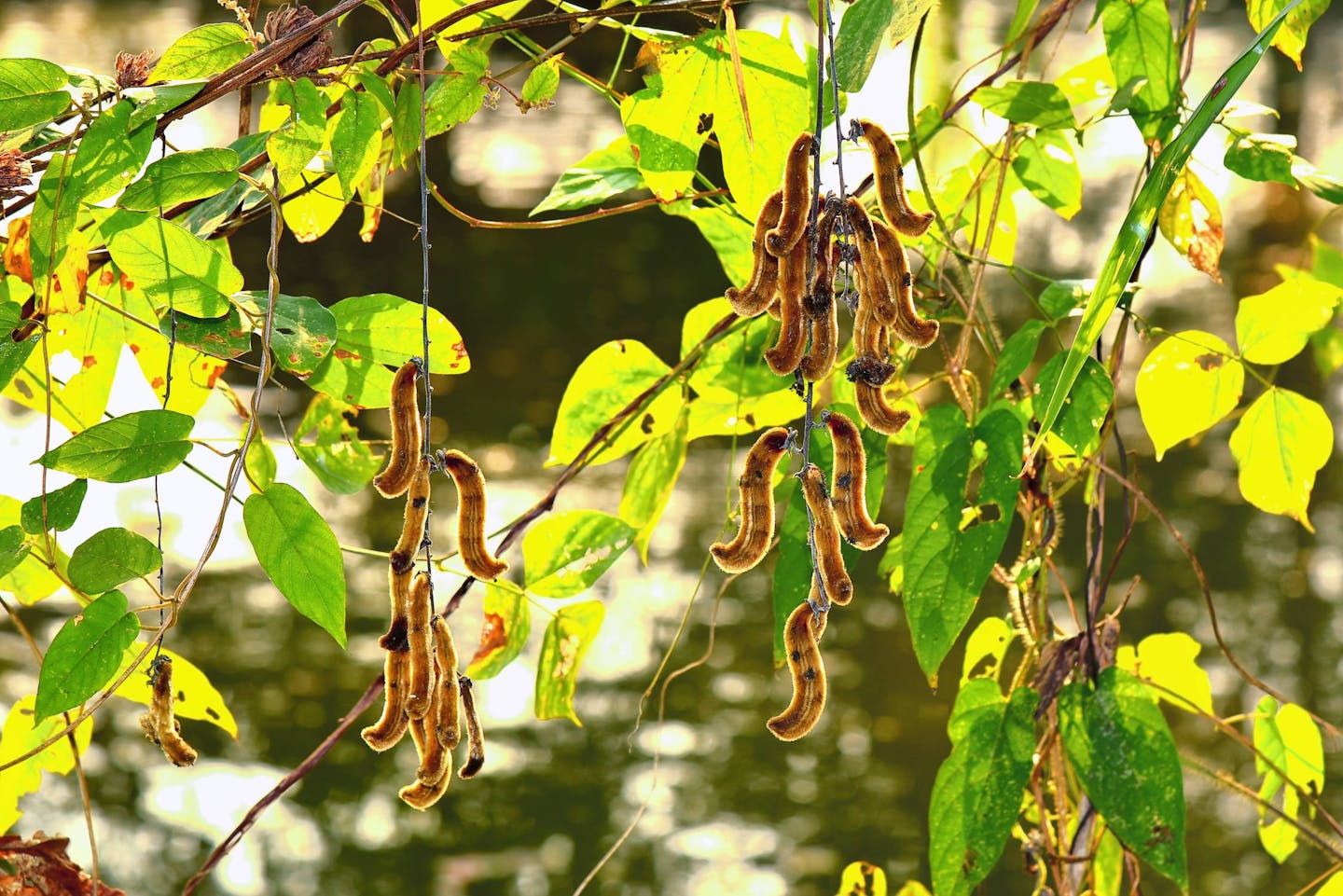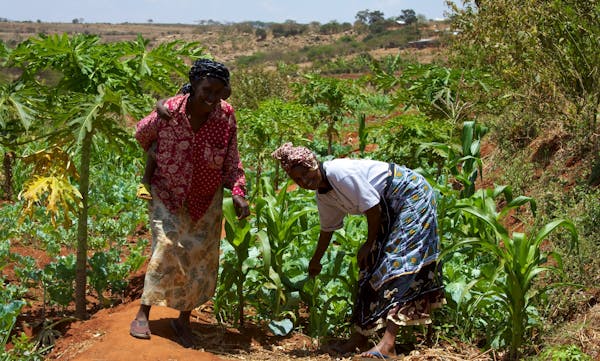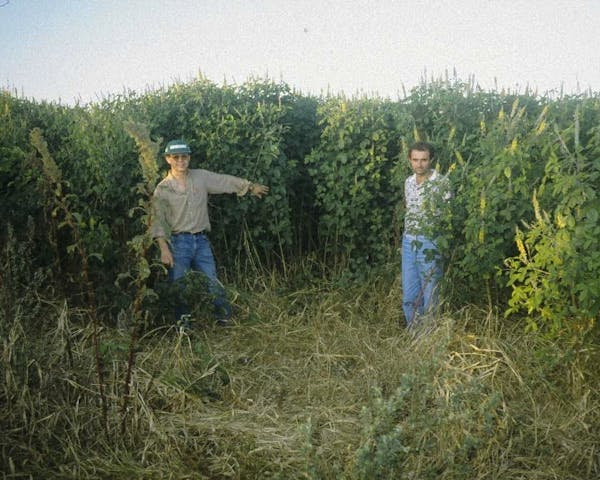Case study 5: world’s cheapest maize
- Regenerative Agriculture
- Regenerative Croplands
- Agroecology
- Polyculture
- Perennial | Superfoods
- Smallholder Farming
- Central America Subrealm
- Central America Realm
Around the 1920’s, the United Fruit Company brought mucuna (also called “velvetbeans”) to Central America to feed the mules they used for carrying bananas out of their fields. We don’t know where or when smallholder farmers began using that mucuna as a gm/cc, or how it spread from one country to another. Nevertheless, today an estimated 25,000 farmers use the maize/mucuna system, solely because of the spread from farmer to farmer.. It is common across about half the northern coast of Honduras, in El Petén of northern Guatemala, and along the east coast of Mexico from the western edge of the Yucatán Peninsula most of the way up to the tip of Texas.
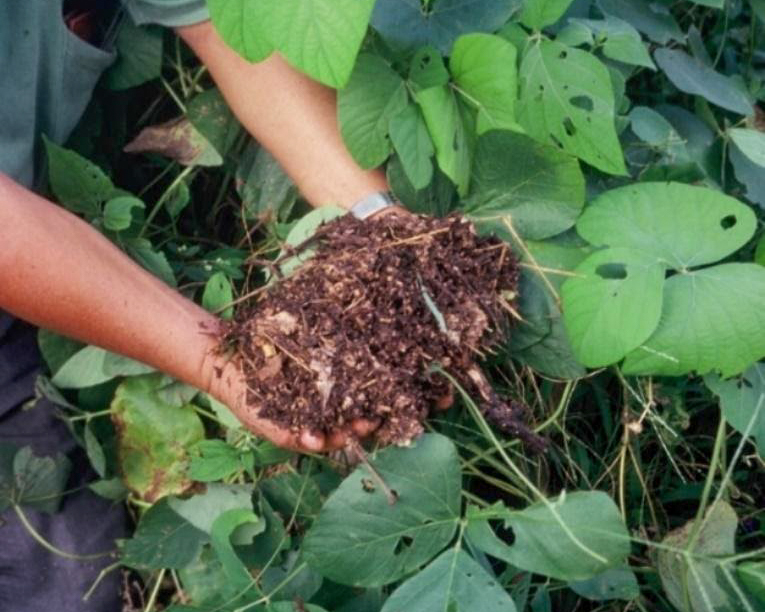
This is the topsoil from a typical field in the maize/mucuna system after having produced maize every year for 40 straight years. It looks like this down to a depth of at least 35 cm. Many scientists in conventional agriculture argue that soil fertility improvement over time is impossible without the use of synthetic fertilizer. This experience, like that of literally millions of farmers around the world, proves that idea to be totally false. Furthermore, this soil absorbs water like a sponge--so much so that even on 30% slopes and in areas where the annual rainfall is well above 2,000 mm, there is no rainwater erosion. The green leaves in the photo are the leaves of the mucuna. We don’t worry about a few perforated leaves on gm/ccs. That just means that insects are already composting some of the biomass for us. Credit: Roland Bunch
The source of the maize/mucuna system’s popularity is no secret. It is easily the simplest and likely cheapest way to grow maize ever devised. This system works only in very humid areas, where total rainfall is well above 2,000 mm/year and it rains all year long. During the wettest part of the year, when no food crops can be grown under the torrents of rain, the mucuna completely covers the field. It protects the soil from erosion because of its complete cover, and produces huge amounts of biomass that, instead of allowing the nutrients to be washed away, recycles them through the mulch about as fast as any system except the humid tropical forest itself. Then, when the rain calms down a bit in December, the mucuna dies and the farmers immediately plant their maize. Within a month or so, the mucuna reseeds itself and starts growing again. Together with the mulch, it completely controls the weeds. In another three or four months, the maize is harvested, the mucuna completely covers the field again, and the cycle repeats itself.
The system requires no machinery, no synthetic fertilizer, and no agricultural chemicals. In fact, it requires no inputs of any kind, except some maize seed from the previous year’s harvest. There’s no need to do soil conservation work, apply fertilizer, make compost, till the soil or bury the mucuna, and usually no need to cut down more than an occasional patch of it. One only needs to weed part of the fields in the rare case that the mucuna did not manage to reseed some patches and therefore left them uncovered. By and large, the only work required is to plant the maize and harvest it. That’s all. Many conventional scientists claim that regenerative and low-input agriculture inevitably require more labor than using chemicals. Hundreds of farming systems put the lie to that little myth, but none as dramatically as the maize/mucuna system.
The maize/mucuna system produces about 30% less maize/ha than the heavily mechanized, heavily fertilized maize fields on the flat land below, but its costs are so low that each bushel of maize is about 25% more profitable than is that of the conventional farmers. And it does this without constantly mining the organic matter out of the soil (thereby destroying much of its natural fertility). Nor does it pump carbon dioxide into the air through the manufacture, transport, and application of synthetic fertilizers. To the contrary, it is regenerating the soil every year, until the 35 cm of topsoil has something on the order of a 12% organic matter content, according to soil analyses. Thus, it is sequestering more carbon in the soil than any other widely used system of producing basic grains anywhere in the world.
So why is this system so efficient and so sustainable?
A group of people I worked with in a Honduran organization called COSECHA, decided in the early 1990s that we needed to find out what kind of agricultural systems would be most sustainable in the tropics. We had been reading textbooks from the temperate world, but they were sending us in one wrong direction after another. These books told us that intercropping did not work, when it was clear from fields all around us that in the tropics, it offered significant advantages. They described how to make hay and silage for our animals to feed them when the ground was covered by snow, but we had no snow. Furthermore, making hay was no use at all when we could grow green forages the year round. They recommended machinery our farmers could never afford, to do jobs, like plowing, that damaged our tropical soils. It went on and on.
Gradually, during 12 years of traveling across Latin America to visit the continent’s most innovative programs and many of its most profitable farmers, we developed a list of five simple principles for a sustainable, regenerative tropical agriculture:
- Keep the soil covered,
- Minimize or eliminate all soil tillage,
- Maximize biomass production,
- Maximize biodiversity, and, strangest of all,
- Feed the crops through the mulch.
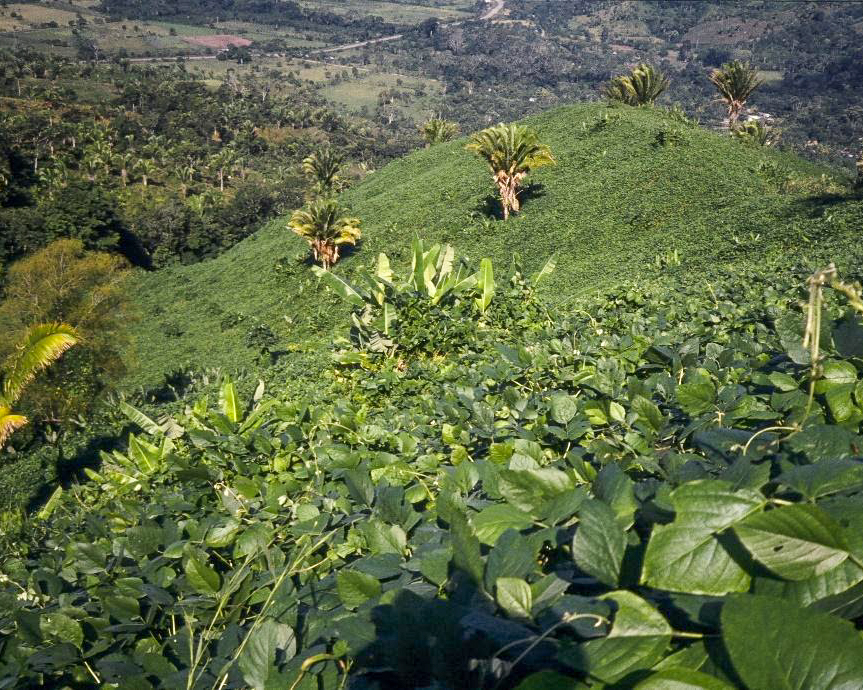
The maize/mucuna system covers many thousands of hectares of smallholder land in each of Mexico, Guatemala and Honduras. Except for a handful of false banana weeds, the half-dozen farms on this hillside are completely covered by non-stop mucuna. The conventional system on the flat land in the background, using fertilizer and tractors, is a good deal less profitable. Credit: Roland Bunch.
Then one day, a year or so later, we were musing about the way these principles fit so well together. For instance, when there’s a lot of biomass and you don’t plow the soil, the soil is automatically going to stay covered. Suddenly it hit us that these principles perfectly described the way a tropical forest works. Had we realized that earlier, we could have saved ourselves many months of work over those 12 years.
After all, nobody has to go out and plow a tropical forest every year, nor does anyone have to spread a mulch across it. Tropical forests have produced huge amounts of biomass for millions of years on some of the world’s poorest soils. How have they managed that neat little trick? By producing a tremendous amount of biodiverse biomass, and then feeding those nutrients to their trees and bushes through the litter layer. This cycle works so fast that these nutrients produce several times more biomass/kg of nutrients/year than they do in conventional agriculture. And the nutrients never touch the soil, where many of them would be immobilized and lost to the system. Yes, feeder roots don’t have to feed from the soil, any more than they do in hydroponics. And they don’t always grow downward. Feeder roots will all happily grow almost straight upward if that’s where dinner is being served.
The maize/mucuna system is both efficient and sustainable because it follows most of these rules very well. It still falls far short in terms of maximizing biodiversity, but it is one of the best biomass producers one will ever find. It keeps the soil covered completely year-round. It requires no tillage, ever. And it feeds its crop through the mulch. No wonder it produces better and better yields for decades until it reaches four times the national average for smallholder farmers, with only a vastly more fertile soil to show for its efforts. No wonder it is so sustainable.
A recent, rather surprising discovery is that the five principles for achieving sustainability in tropical agriculture may well apply to more than just the tropics. Experiences like those of Gabe Brown in North Dakota and Christine Jones in Australia, developed in part with assistance from the same Brazilians who taught so much to us, are showing that at least the first four principles can result in more profitable farms in developed nations. We still need more evidence, but the convergence of practices in these two very different settings may be more than just an astonishing coincidence.
Explore Climate Solutions